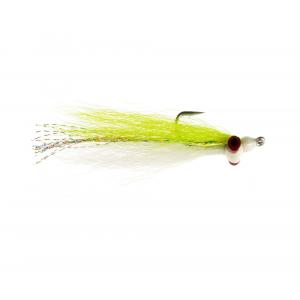Clouser Minnow
Hook:
Mustad 34007 saltwater hook, sizes 1/0 through 8
Thread:
White Danville Flat-Waxed, 6/0
Eyes:
Dumbell eyes (size to match hook)
Belly:
White bucktail
Flash:
Gold Krystal Flash
Back:
Olive bucktail
Head:
Tying thread
The Clouser Minnow is probably the most all-around useful fly ever created. It will catch nearly any freshwater or saltwater fish. The Clouser imitates nearly any baitfish depending on the color scheme, and can even imitate crayfish, shrimp, or crabs. The fly naturally rides hook point up, helping to avoid snags. This fly is most commonly tied with darker colors on the fly's back (while it's swimming) and lighter colors on the belly.
How to tie a Clouser Minnow Fly
Step
1
Start your thread one-third of the entire hook length behind the eye.
Step
2
Place a set of dumbbell eyes directly on top of the thread and begin making figure 8 turns to secure and orient the eyes.
Step
3
Select a small clump of white bucktail and snip it free from the hide. Holding the tips in one hand, pull the shorter butt fibers out of the clump and dispose of them. If there are extra long tips you should get rid of them too.
Step
4
Measure the wing so it's about twice as long as the entire hook then cut the butts off at an angle. And now, while tilting the bucktail, place the butt ends on top of the hook shank. Take a collecting wrap or two, and then nice tight wraps to form a gradual slope. Make sure the bucktail is really secured to the hook. Move your thread to behind the eyes and take a couple of tight wraps to pull the bundle down to the top of the hook shank. Then make several open thread spirals down the hook. Make an additional wrap then spiral the thread back up to a position in front of the eyes.
Step
5
Turn the hook upside down. You're going to have to do this manually if you don't have a rotary vise. If you've got any stray fibers, now's a good time to snip them out.
Step
6
Lay three strands of crystal flash and double over (for six strands total) and secure it just in front of the eyes.
Step
7
Using the same procedure as with the white bucktail used for the belly of the fly, prepare a small bundle of olive bucktail which will form the back of the fly. Again, cutting the bundle on an angle and placing it to the hook shank on an angle, really makes wrapping easier and helps to create a nicely tapered cone-shaped head on the fly.
Step
8
With that done, add a whip finish and give the thread a snip. Apply a liberal amount of cement to the wraps.
